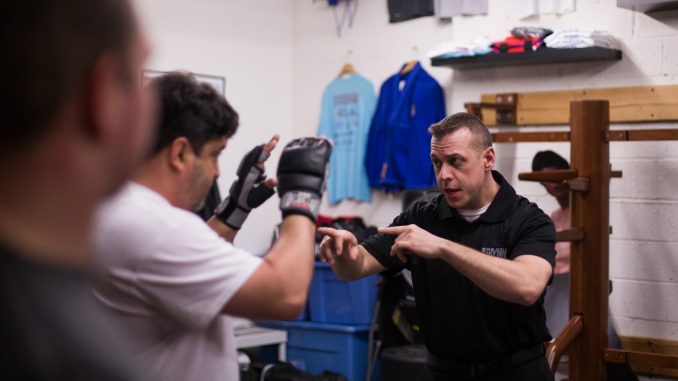
Images of Bruce Lee on a cardboard cutout, a calendar and a poster hang on the walls of Philly Self Defense, a local self-defense martial arts school. But, Temple alumnus Allen Chambers and Joe Nophut, the head instructors of the school, are not teaching their students Bruce Lee’s moves.
As the school name suggests, the two instructors focus their efforts on teaching students practical self-defense against real-world violence through a variety of free classes, private classes and seminars.
Chambers, a web and graphic designer, and Nophut, an electrician, met six years ago, and both have been involved with teaching and learning various styles of martial arts for many years before that. Even after starting Philly Self Defense a year-and-half ago, the two still consider themselves to be learning while teaching.
“We are students of martial arts,” Nophut said. “We love the system and learning and training of the whole process. Much more than just kicks, punches and grappling, we love the anatomy, the psychology of everything, the strategy. And with that being said, we both have very open minds and we continue to learn and expand.”
The primary style of martial arts that is taught at Philly Self Defense is Jeet Kune Do, a foundational discipline which stresses concepts and techniques of self-defense that can actually be utilized.
“The base and mentality of the art is scientific self-defense,” Chambers said. “Not that we don’t do techniques, work out and do drills, but those are just a means to an end. It doesn’t matter how you apply those concepts; as long as you know the concepts well, you can apply them any way you want to.”
Compared to other martial arts that may only concentrate on the specific sets and regiments, Nophut said what drew him to JKD was its practicality.
“It’s one thing to look fancy in the mirror, but to actually be able to perform the task and thoroughly understand the material and apply and teach it,” Nophut added. “We try to train as closely to how we were to perform the task. What we like to say is that we train the way we fight, we fight the way we train.”
This is why an important aspect of teaching the martial art, for Chambers and Nophut, also deals with making sure students know why they are learning something, and making sure they understand that as much as possible.
“The manner in which we teach, we try to clearly explain the objective at hand,” Nophut said. “We try to break it down very, very clearly. You walk away with a clear understanding of what we’re trying to accomplish, why we’re trying to accomplish that.”
Stephen Tomas, a newer student at Philly Self Defense, said it was also important to learn about self-control, which is something Chambers said is not taught enough with other self-defense martial arts.
“These guys are a little bit more nuanced in that you’ve got to address situations appropriately, and your actions should reflect that,” Tomas said.
“Even though [other arts] are reality-based, what tends to happen is, since they’re so realistic, they forget about the subtleties of it,” Chambers said. “There’s no middle ground for most arts.”
With only 12-15 regular students, Chambers and Nophut said they feel their small classroom contributes to the ways they are able to teach the importance of self-defense in a relaxed and personal manner.
“Even though this is a serious topic, we do joke around a lot,” Nophut said. “It’s not like a militant atmosphere, it’s more of a relaxed family atmosphere.”
The two martial artists also hope to instill bravery and calmness in students, so they can make quick decisions in real-life predicaments.
“Being able to handle yourself gives you inner strength, it gives you confidence,” Nophut said. “We push you in stressful situations in here, whether you realize it or not.”
“We’re here to teach them and show them ways they can practice in here and when they go home, they’ve still got their tool,” Chambers said. “They don’t put the tool down and leave without it – they go home with that tool. And even if they never come back, they have that tool to fall back on.”
Albert Hong can be reached at albert.hong@temple.edu.


Be the first to comment